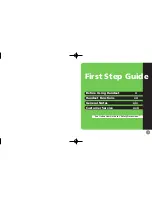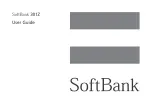
European RF Exposure Information
■
Your mobile device is a radio transmitter and
receiver. It is designed not to exceed the limits
for exposure to radio waves recommended by
international guidelines. These guidelines were
developed by the independent scientific
organization ICNIRP and include safety margins
designed to assure the protection of all persons,
regardless of age and health.
The guidelines use a unit of measurement
known as the Specific Absorption Rate, or SAR.
The SAR limit for mobile devices is 2 W/k
g
.
As mobile devices offer a range of functions,
they can be used in other positions, such as on
the body as described in this user guide*.
Highest SAR value:
Model
At the Ear**
On the Body
940SH
0.481 W/k
g
0.446 W/k
g
As SAR is measured utilizing the device's highest
transmitting power the actual SAR of this device
while operating is typically below that indicated
above. This is due to automatic changes to the
power level of the device to ensure it only uses
the minimum level required to reach the Network.
The World Health Organization has stated that
present scientific information does not indicate
the need for any special precautions for the use
of mobile devices. They note that if you want to
reduce your exposure then you can do so by
limiting the length of calls or using a handsfree
device to keep the mobile phone away from the
head and body.
*Please see Electromagnetic Waves on
P.xiv
for important notes regarding body-worn
operation.
**Measured in accordance with international
guidelines for testing.
FCC Notice
This device complies with part 15 of the FCC
.
Rules. Operation is subject to the following
two conditions:
(1) This device may not cause harmful
interference, and (2) this device must accept
any interference received, including
interference that may cause undesired
operation.
Changes or modifications not expressly
.
approved by the manufacturer responsible for
compliance could void the user's authority to
operate the equipment.
FCC Information to User
■
This equipment has been tested and found to
comply with the limits of a Class B digital
device, pursuant to Part 15 of the FCC Rules.
These limits are designed to provide reasonable
protection against harmful interference in a
residential installation. This equipment
generates, uses and can radiate radio frequency
energy and, if not installed and used in
accordance with the instructions, may cause
harmful interference to radio communications.
However, there is no guarantee that interference
will not occur in a particular installation; if this
equipment does cause harmful interference
to radio or television reception, which can be
determined by turning the equipment off and
on, the user is encouraged to try to correct the
interference by one or more of the following
measures:
1. Reorient/relocate the receiving antenna.
2. Increase the separation between the
equipment and receiver.
3. Connect the equipment into an outlet on a
circuit different from that to which the
receiver is connected.
4. Consult the dealer or an experienced radio/
TV technician for help.
General Notes
xiv
Electromagnetic Waves
For body-worn operation, this phone has been
tested and meets RF exposure guidelines when
used with accessories containing no metal, that
position handset a minimum of 15 mm from
the body. Use of other accessories may not
ensure compliance with RF exposure guidelines.
CE Declaration of Conformity
In some counties/regions, such as France, there are
restrictions on the use of wireless LAN. If you intend to use
wireless LAN on the handset abroad, check the local laws
and regulations beforehand.
Hereby, Sharp Telecommunications of Europe Ltd, declares
that 940SH is in compliance with the essential requirements
and other relevant provisions of Directive 1999/5/EC.
A copy of the original declaration of conformity for each
model can be found at the following Internet address:
http://www.sharp.co.jp/k-tai/
Battery - CAUTION
■
Use specified battery or Charger only.
Non-specified equipment use may cause
malfunctions, electric shock or fire due to
battery leakage, overheating or bursting.
Do not dispose of an exhausted battery with
ordinary refuse; always tape over battery
terminals before disposal. Take battery to a
SoftBank Shop, or follow the local disposal
regulations.
Charge battery in ambient temperatures
between 5
℃
and 35
℃
; outside this range,
battery may leak/overheat and performance
may deteriorate.
Mobile Light
■
Do not use Mobile Light near people's
faces.
Eyesight may be temporarily affected leading to
accidents.
CAUTION:
CLASS 1
LED Product
EN60825-1:1994 A1:2002 & A2:2001
Use of controls, adjustments
or performance of procedure
other than those specified
herein may result in hazardous
radiation exposure. As the emission level from
Mobile Light LED used in this product is harmful
to the eyes, do not attempt to disassemble the
cabinet. Servicing is limited to qualified servicing
station only.
Mobile Light
■
Mobile Light LED Properties
a) Emission Duration: Continuous
b) Wavelength
White: 400 - 700 nm
c) Maximum Emission Output
White: 1.4 mW (4.8 mW inside handset)
xv



























